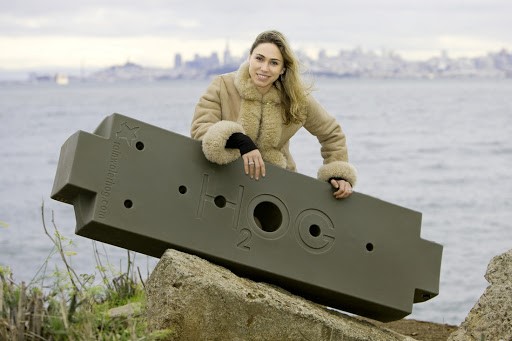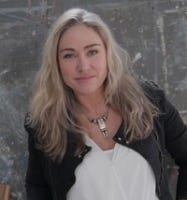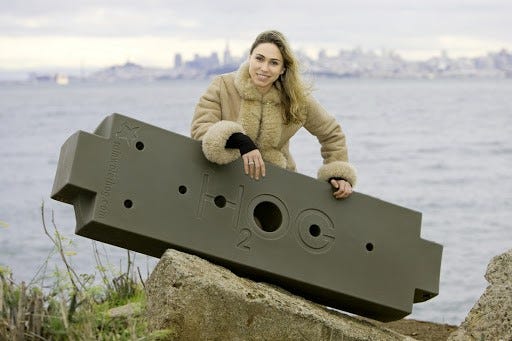Better Innovation Through Adventure: Sally Dominguez On 21st Century Design Thinking
Multi-award-winning inventor, educator, and adventurer Sally Dominguez discusses “Adventurous Thinking,” how engineers and designers can be taught a creative mindset, the importance of being willing to fail, and what all successful organizations have in common.
February 10, 2020

The pressure for engineers and designers to come up with increasingly innovative and novel concepts has never been higher. But how are employees and leadership supposed to adapt in a world where failure has become riskier than ever?
 Sally Dominguez has worn many hats in her career – inventor, educator, journalist, and adventurer. She's spoken all over the world about a modern update to design thinking that she calls Adventurous Thinking. Used by NASA as well as startups and organizations worldwide Dominguez's system points to a methodology for making not only ideas and concepts but existing products, services, and systems more resilient.
Sally Dominguez has worn many hats in her career – inventor, educator, journalist, and adventurer. She's spoken all over the world about a modern update to design thinking that she calls Adventurous Thinking. Used by NASA as well as startups and organizations worldwide Dominguez's system points to a methodology for making not only ideas and concepts but existing products, services, and systems more resilient.
Ahead of her keynote at Pacific Design & Manufacturing 2020, Dominguez spoke with Design News* about the “10X Mindset,” how her Adventurous Thinking framework leads to innovative thinking, and the importance of failure.
Design News: Can you briefly define the Adventurous Thinking framework and talk about how you came about creating it? Were there particular insights or moments in your own career that led you to it?
Sally Dominguez: I had designed my Nest highchair, accidentally pioneering a new rotomolding finish in the process, and it was winning awards and ultimately acquired by the Powerhouse Museum. Then I invented Rainwater HOG and a new structure for flat plastic tanks. I was judging inventions on TV [for ABC's The New Inventors] so I had a reasonable profile with school students and the NSW Board of Studies asked me to lecture to busloads of teens and their design technology teachers about my design process.
I panicked, because my process is so swirly, the opposite to linear. Then I decided to think hard about what that process actually looked like. I considered all the innovators I had interviewed and worked with as well as my own way of thinking, and I started seeing some common angles. As I identified this concept of poking and prodding and questioning I wondered how I could get someone who felt profoundly uncreative to think in the same way. And I came up with the concept of a diverse set of lenses with particular points of view. The lenses would focus a persons thinking in a particular way, but also refract their usual thinking off on tangent to give them results and insights they would never usually find.
DN: Can you briefly describe the Five Lenses of Adventurous Thinking (Negative Space, Thinking Sideways, Thinking Backwards, Rethinking, and Parkour) and how one should go about applying them. Are these a series of steps, or are they more like tools where each can be applied when needed?
SD: [They're] definitely not steps - the Lenses are not a “what you should do” they are a “how you should look at something” based on the theory of multiple intelligences. That is, walking around an issue or thing and poking and pulling from different perspectives gives us greater understanding and meaning, and a proliferation of unexpected options and solutions.
These lenses are not just for ideation. Some are for generating new ideas, but, you know, ideas are worth nothing if you don't do anything with them. The Lenses are designed to apply to an entire process, cradle to grave (or ideally to cradle) and to keep the process decisions and the handovers as open and innovative the entire journey as possible.
Too often all the “innovation” is at ideation and then delivery funnels down into something incremental. The lenses ensure that processes and other parts of the delivery are equally innovative. So you might use “Parkour” to come up with ideas or reinvigorate a project that is losing steam; “Negative Space” and “Sideways” to hone and optimize them and the way a team works together; “Backwards” to ensure the delivery not only of a product or service, but also a campaign is as robust, economical, and sustainable as possible; and “Rethinking to look at a part of the business you have always done the same way and seek either new unexpected markets, or new scales of impact and delivery.
DN: What is the “10X Mindset?” And how does this play into the larger framework of Adventurous Thinking?
SD: The 10X Mindset is the mindset we need to confront the exponential change happening in every facet of our lives right now. The exponential curve is not something humans intuitively understand: We like a linear outlook with a prize at the end and a series of steps. The exponential curves explodes into an ecosystem of stakeholders digitally connected, and this instant connection changes human behavior at a speed and scale we have never seen before.
In order to find opportunity in this chaos we need a mindset that is resilient, opportunistic, and confident with no knowing an answer or an outcome. It's the opposite of the classic MBA mindset. This is brand new territory. Adventurous Thinking developed in order to show people how the “swirly” thinking of many creative innovators worked, and it turns out to be the perfect mindset to stay optimistic and on point in an era of unrelenting change.
|
(Sally Dominguez with one of her inventions -- the Rainwater HOG tank for rain water storage. (Image source: Sally Dominguez) |
DN: Adventurous Thinking seems based a lot around the idea of creating a flexible mindset that's open to change. In your observation why are we so resistant and rigid in our thinking to begin with?
SD: We are simply comfortable in our expertise. Logic and knowledge are celebrated throughout our schooling and far prioritized over creative thinking. Einstein said it best: "Imagination is more important than knowledge. For knowledge is limited, whereas imagination embraces the entire world, stimulating progress, giving birth to evolution.” Thinking in the area of possibility is hard because we don't know the answers and we can't look them up. It is not a place people default to unless they have practiced it and they know the exhilaration it can bring.
DN: Your site mentions “A key premise of Adventurous Thinking is a willingness to fail.” Can you elaborate a bit on this? How can a willingness to fail be an asset? How do you tell your clients how to reconcile this mindset in a work environment that is increasingly driven by performance and deadlines – where failure may not be welcomed or encouraged?
SD: In order to plan business strategy and run the day to day in this new environment of unrelenting change leaders and their teams need to have a stated strategy around failure. Companies are not seeing the growth they have historically been able to plan for because 10% better is no longer yielding results. Change happens too fast, products and services can be copied too fast. Growth will only come with bigger, bolder innovations and those are higher risk. But cheaper to try than ever before.
The new business environment facing everyone in this new era demands an alternative to classic risk-averse planning, but you can't just tell people who are employed to do a job that suddenly it's cool to fail. Failure needs to be demonstrated with full transparency by leadership, outlined in company expectations and assessed during performance reviews.
For instance Coke’s 70/20/10 market strategy is a good one: You could tell your team 70% of the time do what you know works, 20% of the time try leading edge developments, 10% of the time try something that nobody else has done. And here is some training and tools to help you get to that space, that moonshot thinking. If every person in an organization is enabled to spend some of their time innovating with 10X thinking in their area, a company will see consistent growth. Failure needs to be defined and the scope built into the Innovation Scaffold of company strategy.
DN: Do you differentiate a “willingness” to fail from “accepting” failure?
SD: I think you need to accept that the failure will ultimately move you forward, and in many areas of disruptive innovation you need to accept that your endeavor will most likely fail, without letting that stop you trying. Failing fast is the key. We need to aim higher – understand that means a high failure rate, yet still try.
DN: You've worked with a lot of different companies, organizations, and innovators. Are there certain qualities you've observed in your career that successful people and organizations seem to naturally have in common?
SD: The ability to take and give constructive criticism is a key attribute with consistent innovators. If you are working at the bleeding edge you need to be able to hear and appreciate the concerns and morph if necessary, but also be resilient enough to back yourself against criticism – again, without taking it personally. I think always being receptive to adjacent opportunities is the hallmark of an innovator working in the exponential change of the Fourth Revolution. And then convincing others to come along for the wild ride!
DN: You've spoken all over the world. Have you observed certain challenges or mindsets that differentiate between cultures? Are there needs and challenges that are unique to the U.S. for example?
SD: Culture definitely has a big impact on collaboration and the way we think about problems. There is a great book called Geography of Thought that looks at the difference between Aristotle thinking - like the USA – that places the individual as the focus – and Confucian thinking, which is more socially oriented. Those are two completely different ways to consider an issue and they can deliver starkly different results with the same Adventurous Thinking tools.
I left Australia because it has “Tall Poppy Syndrome,” which means you can't tell people you are good at something or invent something without people wanting to cut you down. Same in Japan and the UK. So that affects the way people talk about their ideas with others. In California you tell someone an idea and they immediately support you and ask how they can help... at least that is how it is where I live!
So, again, that makes a huge difference to the way we share ideas and co-create. I love the USA for idea-sharing, but it is also the place where both my main inventions were ripped off because people are very commercially minded. Latin America is an exciting region in terms of idea sharing and co-creation. Super interested and proactive with new mindset tools, and extremely social and optimistic which helps when dealing with bearable discomfort.
DN: As an innovator yourself, are there any new innovations you find particularly exciting?
SD: I am excited that the rise in unexpected technologies - for example the conversion of CO2 to energy and the creation of hydrogen using solar, and the creation of meat substitutes with yeast - means we can rethink some big planet challenges around sustainable fuels, food production, and a bunch of other complex global issues. I am trying to work out which exponential technologies I could potentially harness to rethink the way we fight bushfires like the ones that have decimated Australia’s native wildlife.
Sally Dominguez will be delivering the closing keynote, “Adventurous 10X Thinking – Building the Resilient Mindset for Better Innovation” on Thursday February 13th at 1:30PM at Pacific Design & Manufacturing 2020.
*This interview has been edited for content and clarity.
RELATED ARTICLES:
About the Author(s)
You May Also Like




